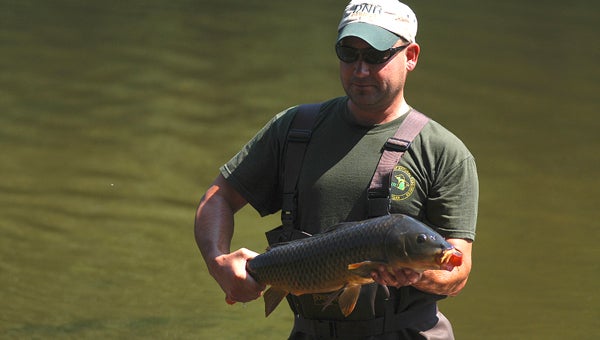MDNR prepares for possible Asian carp invasion
Published 4:42 pm Tuesday, September 10, 2013

Vince Balcer, MDNR fisheries technician, holds up a common carp captured Tuesday in the St. Joseph River.
Leader photo/CRAIG HAUPERT
BERRIEN SPRINGS — Silver and bighead carp, more commonly referred to as species of the infamous Asian Carp, haven’t been found recently in Michigan’s waters, according to the Michigan Department of Natural Resources.
That doesn’t mean they won’t eventually swim their way into Michigan’s lakes or rivers, like the St. Joseph River.
That’s why the MDNR’s Fisheries Division was in Berrien County Tuesday conducting a field exercise for catching and removing the invasive species of fish, in the case that they do reach Michigan’s waterways.
“I don’t know whether the fish will ever get into the Great Lakes — that’s the million dollar question,” said Tom Goniea, Sr. Fisheries Biologist with the MDNR. “We are all working to make sure that doesn’t happen. But, if we didn’t think it was possibility, we wouldn’t be doing this exercise today. We want to be prepared if that does become a reality we have to respond to.”
Around 30 employees of the Fisheries Division conducted the exercise Tuesday on a 2-mile stretch of the St. Joseph River near the Jasper Dairy boat launch north of Berrien Springs.
The exercise consisted of placing gill nets upstream and downstream in the river to catch fish and to keep them from coming in our out. Then, Fisheries Division staff used several boats outfitted with electrofishing technology to catch, tag and release any species of common carp or black buffalo found.
Nearly 100 fish were already caught and tagged by early Tuesday afternoon.
Goniea said electrofishing works when a boat sends an electric current into the water, forming an electric field of about 10-15 feet around the boat. Stunned fish then float to the surface where they are tagged and measured.
“Electrofishing has a very low mortality rate for the fish. It allows us to catch fish, take any kind of data that we want and then release them alive back into the water,” he said.
Goniea said they were focusing on catching species of grass carp, common carp and black buffalo because those species are non-native and similar to Asian Carp. Caught fish were tagged and placed back into the river. Grass Carp, a species banned in the area, were removed from the river.
On Wednesday, Fisheries Division employees will attempt to re-capture tagged fish in an effort to determine the effectiveness of their methods.
“It does no good to catch 20 fish if you don’t know there are 100 fish or a 1,000 fish out there,” said Goniea. “If you know how many fish are out there to begin with you know whether or not catching 20 fish is a good day or not.”
To his knowledge, Goniea said this is the first time the state has used a combination of gill nets and electrofishing gear in a riverine system.
“We’ve done it before in a lake, but never effectively done it in a riverine system. This is first trial case where a department or division has attempted to practice or prepare for silver or bighead carp. It really is a first of its kind.”
The MDNR chose the St. Joseph River because it is the first major river system fish moving up the Michigan shoreline form the Chicago Area Waterway System (CAWS) would encounter. The CAWS is believed to be the most likely source of Asian carp moving in the Great Lakes.
“These fish tend to gravitate to slower moving areas, they tend to gravitate toward holes, deeper water… this would be an area fish would tend to stage in during a pre-spawning event,” Goniea said.
Asian Carp is an invasive species of fish considered to be a threat to Michigan and the Great Lakes.





